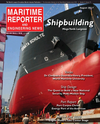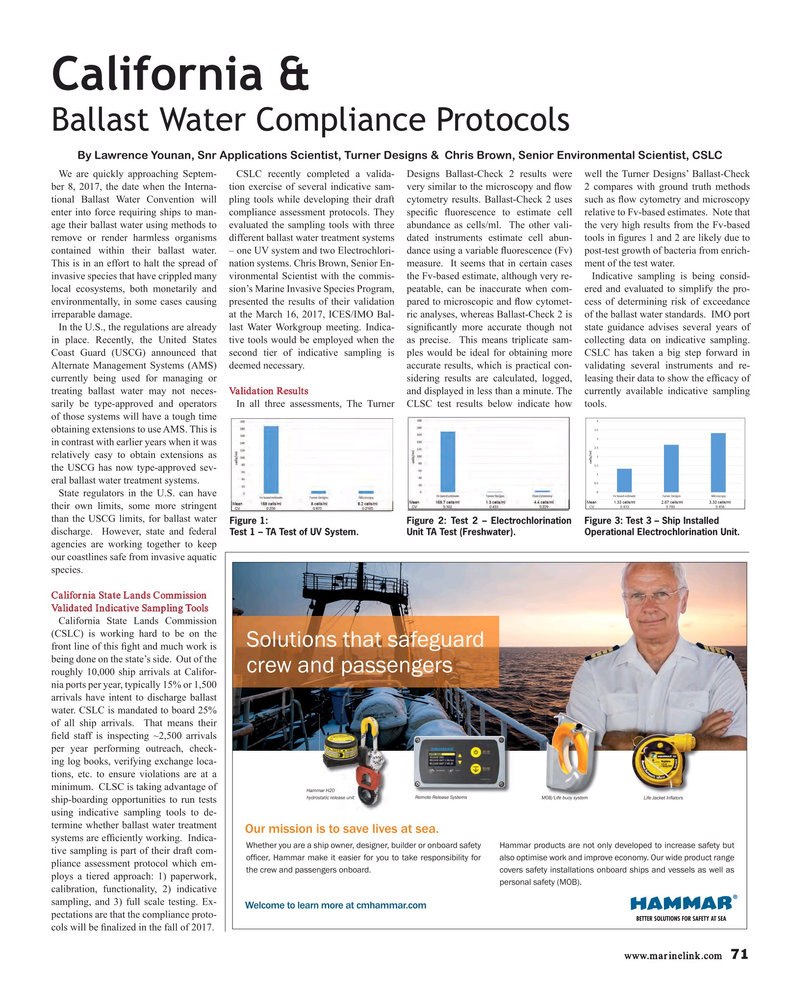
Page 71: of Maritime Reporter Magazine (August 2017)
The Shipyard Edition
Read this page in Pdf, Flash or Html5 edition of August 2017 Maritime Reporter Magazine
California &
Ballast Water Compliance Protocols
By Lawrence Younan, Snr Applications Scientist, Turner Designs & Chris Brown, Senior Environmental Scientist, CSLC
We are quickly approaching Septem- CSLC recently completed a valida- Designs Ballast-Check 2 results were well the Turner Designs’ Ballast-Check ber 8, 2017, the date when the Interna- tion exercise of several indicative sam- very similar to the microscopy and ? ow 2 compares with ground truth methods tional Ballast Water Convention will pling tools while developing their draft cytometry results. Ballast-Check 2 uses such as ? ow cytometry and microscopy enter into force requiring ships to man- compliance assessment protocols. They speci? c ? uorescence to estimate cell relative to Fv-based estimates. Note that age their ballast water using methods to evaluated the sampling tools with three abundance as cells/ml. The other vali- the very high results from the Fv-based remove or render harmless organisms different ballast water treatment systems dated instruments estimate cell abun- tools in ? gures 1 and 2 are likely due to contained within their ballast water. – one UV system and two Electrochlori- dance using a variable ? uorescence (Fv) post-test growth of bacteria from enrich-
This is in an effort to halt the spread of nation systems. Chris Brown, Senior En- measure. It seems that in certain cases ment of the test water.
invasive species that have crippled many vironmental Scientist with the commis- the Fv-based estimate, although very re- Indicative sampling is being consid- local ecosystems, both monetarily and sion’s Marine Invasive Species Program, peatable, can be inaccurate when com- ered and evaluated to simplify the pro- environmentally, in some cases causing presented the results of their validation pared to microscopic and ? ow cytomet- cess of determining risk of exceedance irreparable damage. at the March 16, 2017, ICES/IMO Bal- ric analyses, whereas Ballast-Check 2 is of the ballast water standards. IMO port
In the U.S., the regulations are already last Water Workgroup meeting. Indica- signi? cantly more accurate though not state guidance advises several years of in place. Recently, the United States tive tools would be employed when the as precise. This means triplicate sam- collecting data on indicative sampling.
Coast Guard (USCG) announced that second tier of indicative sampling is ples would be ideal for obtaining more CSLC has taken a big step forward in
Alternate Management Systems (AMS) deemed necessary. accurate results, which is practical con- validating several instruments and re- currently being used for managing or sidering results are calculated, logged, leasing their data to show the ef? cacy of treating ballast water may not neces- Validation Results and displayed in less than a minute. The currently available indicative sampling sarily be type-approved and operators In all three assessments, The Turner CLSC test results below indicate how tools. of those systems will have a tough time obtaining extensions to use AMS. This is in contrast with earlier years when it was relatively easy to obtain extensions as the USCG has now type-approved sev- eral ballast water treatment systems.
State regulators in the U.S. can have their own limits, some more stringent than the USCG limits, for ballast water
Figure 1: Figure 2: Test 2 – Electrochlorination Figure 3: Test 3 – Ship Installed discharge. However, state and federal
Test 1 – TA Test of UV System. Unit TA Test (Freshwater). Operational Electrochlorination Unit. agencies are working together to keep our coastlines safe from invasive aquatic species.
California State Lands Commission
Validated Indicative Sampling Tools
California State Lands Commission (CSLC) is working hard to be on the
Solutions that safeguard front line of this ? ght and much work is being done on the state’s side. Out of the
FUHZDQGSDVVHQJHUV roughly 10,000 ship arrivals at Califor- nia ports per year, typically 15% or 1,500 arrivals have intent to discharge ballast water. CSLC is mandated to board 25% of all ship arrivals. That means their ? eld staff is inspecting ~2,500 arrivals per year performing outreach, check- ing log books, verifying exchange loca- tions, etc. to ensure violations are at a minimum. CLSC is taking advantage of
Hammar H20 hydrostatic release unit Remote Release Systems MOB/Life buoy system /LIH-DFNHW,QÁDWRUV ship-boarding opportunities to run tests using indicative sampling tools to de- termine whether ballast water treatment
Our mission is to save lives at sea.
systems are ef? ciently working. Indica-
Whether you are a ship owner, designer, builder or onboard safety +DPPDUSURGXFWVDUHQRWRQO\GHYHORSHGWRLQFUHDVHVDIHW\EXW tive sampling is part of their draft com-
RIÀFHU+DPPDUPDNHLWHDVLHUIRU\RXWRWDNHUHVSRQVLELOLW\IRU DOVRRSWLPLVHZRUNDQGLPSURYHHFRQRP\2XUZLGHSURGXFWUDQJH pliance assessment protocol which em-
WKHFUHZDQGSDVVHQJHUVRQERDUG FRYHUVVDIHW\LQVWDOODWLRQVRQERDUGVKLSVDQGYHVVHOVDVZHOODV ploys a tiered approach: 1) paperwork,
SHUVRQDOVDIHW\02% calibration, functionality, 2) indicative sampling, and 3) full scale testing. Ex-
Welcome to learn more at cmhammar.com pectations are that the compliance proto- cols will be ? nalized in the fall of 2017.
www.marinelink.com 71
MR #8 (66-73).indd 71 MR #8 (66-73).indd 71 8/7/2017 2:54:41 PM8/7/2017 2:54:41 PM

 70
70

 72
72
